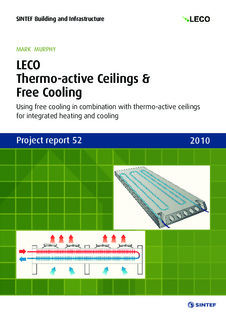| dc.contributor.author | Murphy, Mark Allen | |
| dc.date.accessioned | 2016-11-04T20:15:38Z | |
| dc.date.accessioned | 2016-11-15T14:35:23Z | |
| dc.date.available | 2016-11-04T20:15:38Z | |
| dc.date.available | 2016-11-15T14:35:23Z | |
| dc.date.issued | 2010 | |
| dc.identifier.isbn | 978-82-536-1135-8 | |
| dc.identifier.isbn | 978-82-536-1135-8 | |
| dc.identifier.issn | 1504-6958 | |
| dc.identifier.uri | http://hdl.handle.net/11250/2421162 | |
| dc.description.abstract | The largest potential for decreasing green house gas emissions, and therewith mitigating the effects of global climate change, comes from improving energy efficiency. Through the integration of heating and cooling systems into building elements, such as the thermo-active ceiling, improvements in energy efficiency can be achieved.
Utilizing thermal mass to buffer temperature variations and to level out peak loads reduces the instantaneous power demands and enables traditional cooling equipment to operate in temperature ranges with higher coefficients of performance. Additional savings in both energy and money can be obtained through the use of free cooling, especially in northern
climates. As the coolant temperature in a thermoactive ceiling approaches room temperature, the cooling potential of outdoor ambient air increases. This temperature difference enables free cooling at the mere cost of blowing outdoor air through a heat exchanger.
This paper investigates the savings potential of thermo-active ceilings combined with free cooling using the building simulation software TRNSYS. A reference building is simulated with and without the thermo-active ceiling and free cooling combination through a range of different internal heat gains in a Nordic climate similar to Chicago.
The thermo-active ceiling succeeds in cooling away internal heat gains up to 50 W/m2. During the majority of the year, the office building has a cooling demand that can be met entirely by free cooling. Less than 10 percent of the annual cooling demand must be obtained in addition to free cooling. The savings potential ranges between 8 and 16 kWh/m2 when compared to a traditional system using a heat pump to supply cooling. | nb_NO |
| dc.language.iso | eng | nb_NO |
| dc.publisher | SINTEF Byggforsk | |
| dc.relation.ispartofseries | Prosjektrapport (SINTEF Byggforsk);52 | |
| dc.subject | Energy | nb_NO |
| dc.subject | Termo-active elements | nb_NO |
| dc.subject | Low-energy cooling | nb_NO |
| dc.subject | Cooled ceilings | nb_NO |
| dc.subject | Free cooling | nb_NO |
| dc.subject | Thermal mass | nb_NO |
| dc.subject | Building simulation | nb_NO |
| dc.subject | Energibruk | nb_NO |
| dc.subject | Kontorbygg | nb_NO |
| dc.title | Leco. Thermo-active Ceilings & Free Cooling. Using free cooling in combination with thermo-active ceilings for integrated heating and cooling | nb_NO |
| dc.title.alternative | Leco | nb_NO |
| dc.title.alternative | Thermo-active Ceilings & Free Cooling. Using free cooling in combination with thermo-active ceilings for integrated heating and cooling | nb_NO |
| dc.type | Research report | nb_NO |
| dc.date.updated | 2016-11-04T20:15:38Z | |
| dc.description.version | publishedVersion | |
| dc.rights.holder | © 2010 SINTEF Building and Infrastructure | nb_NO |
| dc.subject.nsi | VDP::Technology: 500 | nb_NO |
| dc.identifier.cristin | 1267978 | |
| dc.description.localcode | 3B015100 | nb_NO |
